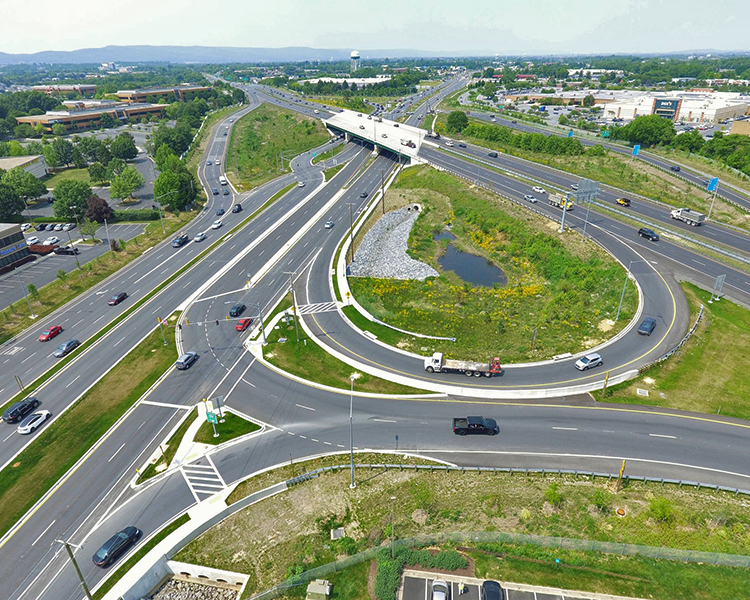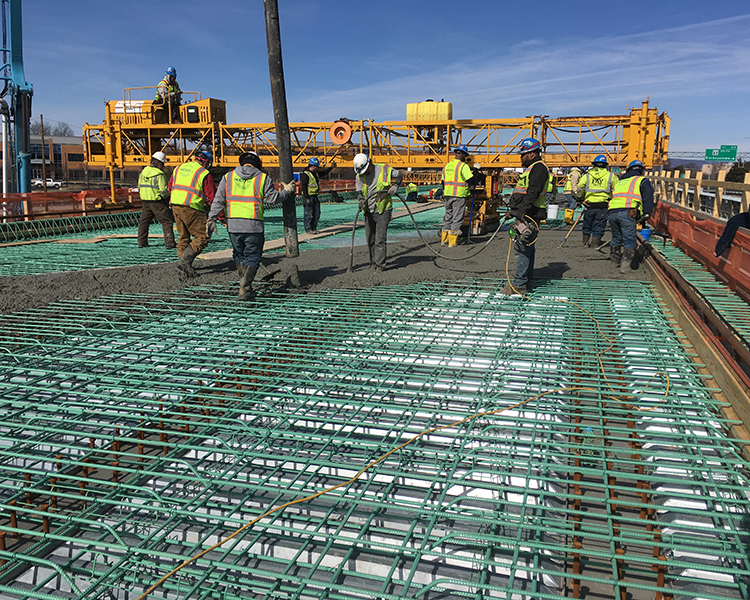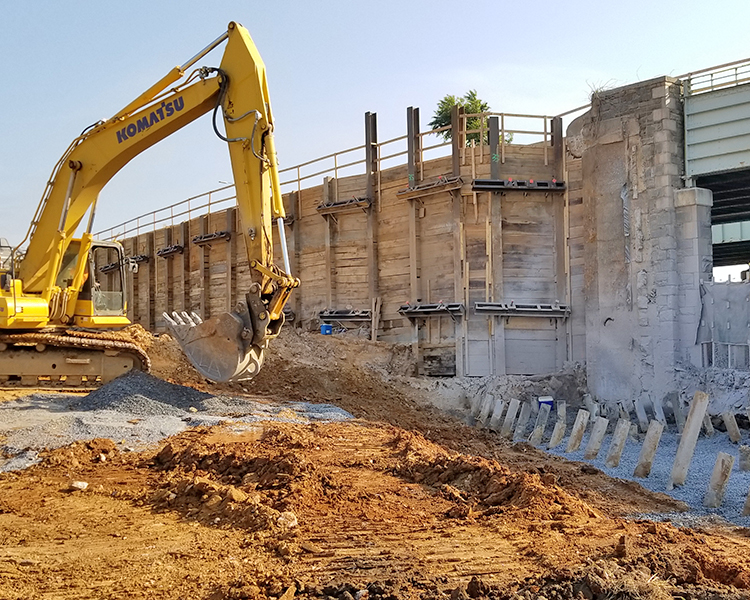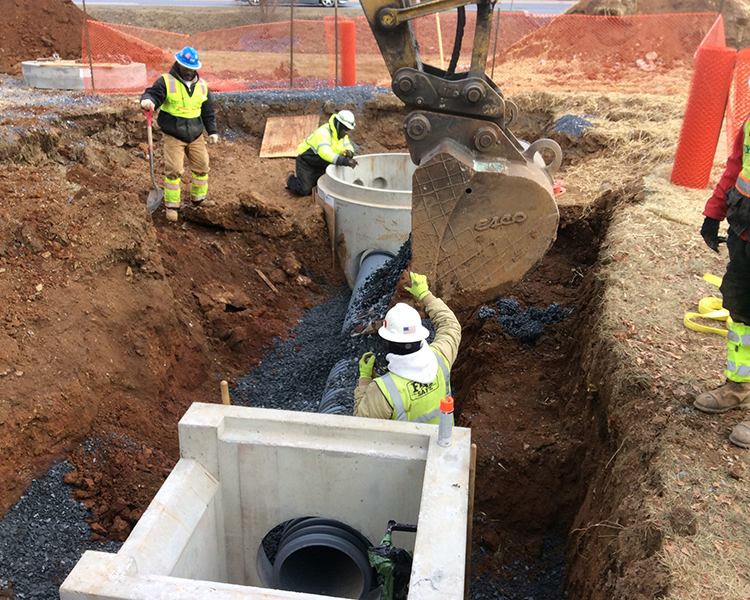MD85 at I-270 Interchange Reconstruction
| Location: | Frederick, MD |
| Owner: | Maryland Department of Transportation, State Highway Administration |
| Construction Company: | Fay, S&B USA Construction |
| Project Status: | Completed in January 2023 |
Fay Solves Geology, Drainage, Utility and Schedule Challenges at Busy Interstate Interchange
Project Highlights
- Removal of I-270 twin single-span bridges over MD 85 and construction of a single three-span, 450-ft by 120-ft structure
- Build a hybrid ramp crossover interchange (HRCI) featuring an innovative partial diverging diamond configuration
- Over two miles of roadway reconstruction and resurfacing
- Widen MD 85
- 16,000 vertical feet of micropiles to combat geological issues and provide a solid foundation for the new bridge
- Over 25,000 lf of stormwater drainage, water main, and sanitary sewer lines and 375 stormwater management structures
- Coordination of complex utility relocations with nine different utility companies
The MD 85 and I-270 Interchange Reconstruction Project was one component of the Maryland Department of Transportation State Highway Administration (MDOT SHA) efforts to provide corridor improvements along 30 miles of I-270 between I-70 and I-495 to reduce congestion and improve safety. In addition to removing and replacing twin I-270 bridges over MD 85 and reconstructing the interchange, the project also improved approximately 1.3 miles of I-270 and 1.1 miles of MD 85, including an extra travel lane in each direction of MD 85.
Challenges:
- At the time of construction, traffic volume at the MD 85 and I-270 interchange exceeded 130,000 average daily traffic (ADT) and is expected to increase to almost 182,000 ADT by 2030. The dual I-270 bridges built in 1954 were poorly rated and the existing interchange no longer effectively managed the increasing traffic volumes in the fast-growing Frederick area.
- The mainly karst (large limestone deposits) geology of Frederick County required a strong foundation solution.
- Utility relocations were also a significant part of the project, requiring coordination with nine different utility owners to ensure the work was completed on schedule and avoided conflicts.
Solutions:
Fay removed and replaced the existing I-270 twin bridges over MD 85 with a single three-span, 450-ft by 120-ft structure to carry both directions of traffic. To counter the karst geology issue, Fay installed 16,000 vertical feet of micro piles penetrating the karst and solid bedrock. After the steel-encased micro piles were drilled into the bedrock, concrete grout was pumped into them to stiffen the pile, effectively mitigating the geology issues and improving the safety and structural stability of the bridge.
One of the project’s standout features is the introduction of a hybrid ramp crossover interchange (HRCI) to carry northbound and southbound MD 85 traffic onto northbound I-270 by constructing an innovative partial diverging diamond configuration. This design accommodates high traffic volumes by using the opposite side of the road at a cross point controlled by traffic signals. The new interchange minimizes potential conflicts from oncoming traffic, shortens wait times and enhances sight lines. A marvel of engineering efficiency, the HRCI’s compact configuration provides substantial cost savings and reduces its environmental footprint under the I-270 bridge compared to other studied interchange configurations.
The HRCI is also more operationally efficient because it uses a simple two-phase signal system at each intersection. This reduces control delays and expedites the construction process, enabling the contractor to adhere to strict construction timelines without compromising the quality or safety of the project. The simplicity of the design also means less long-term maintenance, providing additional cost savings for the state and taxpayers.
Additionally, the Fay team presented a value engineering alternative to the client’s proposed storm drain system that reduced costs, increased quality and safety, and significantly reduced potential environmental impacts from stormwater.
Construction
While there were originally nine maintenance of traffic phases planned, the team eliminated one of the phases and accelerated progress in two others, effectively consolidating the schedule and reducing the project’s impact on the traveling public. To minimize traffic disruptions, Fay also worked a night shift during the entire project to perform work under temporary lane and ramp closures.
A key improvement of this project was realigning on and off ramps, which enhanced traffic flow from northbound and southbound MD 85 onto northbound I-270. To relieve traffic congestion, the HRCI was constructed to separate northbound MD 85 traffic. Northbound MD 85 traffic to northbound I-270 now has its own dedicated ramp, improving flow and reducing congestion.
To improve safety, Fay also provided a design to reposition hundreds of feet of 8-inch sewer pipe initially planned to run down the middle of MD 85 to the shoulder of the roadway. This strategic relocation allowed the work to be executed away from traffic and during daylight hours, substantially enhancing safety measures. The adjustment also minimized potential hazards associated with traffic interference, affirming the project’s commitment to ensuring the safety of both the construction crew and the public.
Fay managed utility relocations by collaborating with the stakeholders in monthly coordination meetings to plan work schedules and ensure progress.
The project also included the widening of ramps and installation of new stormwater structures, ADA compliant ramps and bicycle lanes, making it a comprehensive solution to the area's growing transportation needs.
Additionally, Fay used the MDOT SHA Quality Assurance Toolkit for erosion and sediment (E&S) modifications, resulting in time savings and reduced environmental impacts. The project received an 'A' grade on all seven MDOT SHA E&S control quality assurance inspection reports.
Our Team is Ready to Help You
To learn how our team of heavy construction experts can help solve your infrastructure challenge with safe and innovative solutions, contact us.



